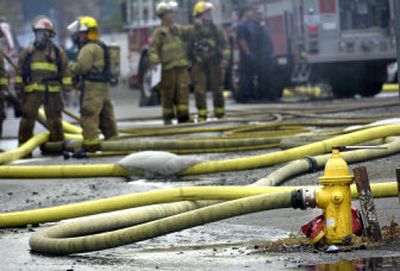Valley testing finds 60 weak hydrants, increases pressure on water districts

Beside the east shore of Liberty Lake, on the hillsides overlooking Spokane Valley and in scattered neighborhoods below, homes surround about 60 fire hydrants that might not provide enough water to put out a fire.
Water pressure is critical to firefighters, who can run through a pumper truck’s 700-gallon tank in less than five minutes.
Unlike other urban areas with a single, interconnected water utility, hydrants that supply firetrucks working in the Valley are owned by 28 entities.
“There are so many little individual districts to work with,” said Spokane Valley Fire Chief Mike Thompson.
Many irrigation and water districts were formed generations ago and have a limited tax or customer base to pay for upgrades. Others were installed by developers in high-end housing projects, only to be handed over to homeowners who now face costly upgrades to water mains.
Last summer, crews wrenched open each of the 4,851 hydrants within the department’s boundaries to check water pressure. The fire code’s standard for hydrants in new subdivisions is 1,000 gallons per minute.
“There are areas of the Valley that don’t have those numbers,” said Spokane Valley Fire Marshal Kevin Miller.
An analysis of test results indicates about a third of the residential hydrants in the fire district fail to meet that standard, and a handful fall below 530 gallons per minute – a level that prompts the department to ask water providers to upgrade their systems.
On the east side of Liberty Lake, for example, nearly a fourth of 22 privately owned hydrants test at less than 400 gpm, with three on Neyland Road testing at 210 gpm.
“If we have one of those lakefront houses on fire, we’re going to have to shuttle water,” Miller said.
The Eastside Liberty Lake Improvement Club formed more than 50 years ago to provide the water service.
“Most of everything out here was summer cabins,” said system manager Denise Coyle.
As lakeside retreats gave way to year-round houses, the group has replaced some original water lines and installed meters.
While the organization can adjust rates and levy assessments from its members, the improvement club and other smaller systems lack the economies of scale that would allow bigger systems to bankroll capital improvements quicker.
“With only 200 customers, that’s not a big area to draw from,” Coyle said.
The risk posed by low water pressure is compounded by the threat of wildfires in some Liberty Lake neighborhoods and on hillsides above Otis Orchards.
Just up the hill from the improvement club’s customers, a quiet, wooded neighborhood on Green Ridge Drive offers dramatic vistas of Liberty Lake and Idaho’s Pleasantview Valley.
Homeowners own the water system that serves residents along the dead-end street with eight hydrants. Half tested at pressures below 530 gpm.
Twelve of the 68 residential hydrants in East Spokane Water District showed low pressure, with all but three of those located in the newer Beverly Hills neighborhood that backs up to Dishman Hills Natural Area.
The district, which serves about 3,300 people, hopes it will receive a federal grant to install a new reservoir soon that will provide more pressure, said manager Rick Adkins.
After the Fire Department completes hydrant testing, it notifies districts of problems.
Encroaching shrubbery is removed, broken hydrants are fixed, and in some cases fixing low water pressure is as simple as turning a valve a contractor forgot to reopen.
Larger systemic problems, though, must be worked into a water system’s multiyear water plan required by the state.
“It’s up to the purveyor to figure out a solution,” Adkins said.
His district is eligible for federal money because a large percentage of its customers fall below a certain income level. Bonds and water rates have helped replace many of the old 4-inch mains with 8-inch or 12-inch pipe, but Adkins said grants also have made much of the work possible.
Nearby Carnhope irrigation district in the Edgecliff neighborhood had five hydrants test below 530 gpm between Ninth Avenue and Interstate 90.
In service areas of the Valley’s two largest water purveyors, Vera Water and Power had eight low-flowing hydrants and Consolidated Irrigation District owned three.
July’s tests identified seven hydrants in the Pasadena Park Irrigation District with low pressure, although most of those were fixed during a sewer project that occurred after the testing, said manager Kathleen Small.
Others were part of a privately owned system that the water district recently agreed to take over.
Her husband lost his home in Greenbluff to fire when he was 11, Small said, and she takes fire hydrant pressure seriously. Within a week of fire officials notifying the organization of a problem, the district fixes it or lets the fire district know what it plans to do in the future.
Even with a revenue boost from 500 new houses connecting to the system in the past eight years, raising money from customers in a smaller district can take a long time.
“We’re a community service, we’re not a moneymaking business here,” Small said.
In many older areas, hydrants being replaced were built to provide only 500 gpm.
The standard for residential hydrants increased to 1,000 gpm in recent decades as new buildings began to include more combustible materials, Thompson said.
The Valley’s commercial areas tend to be well-pressurized, Thompson said.
They require at least 1,500 gpm, although the rules are different for buildings with sprinkler systems.
All in all, Thompson said pressure in the Valley’s residential areas has been improving in recent years, with more districts establishing emergency connections to each other.